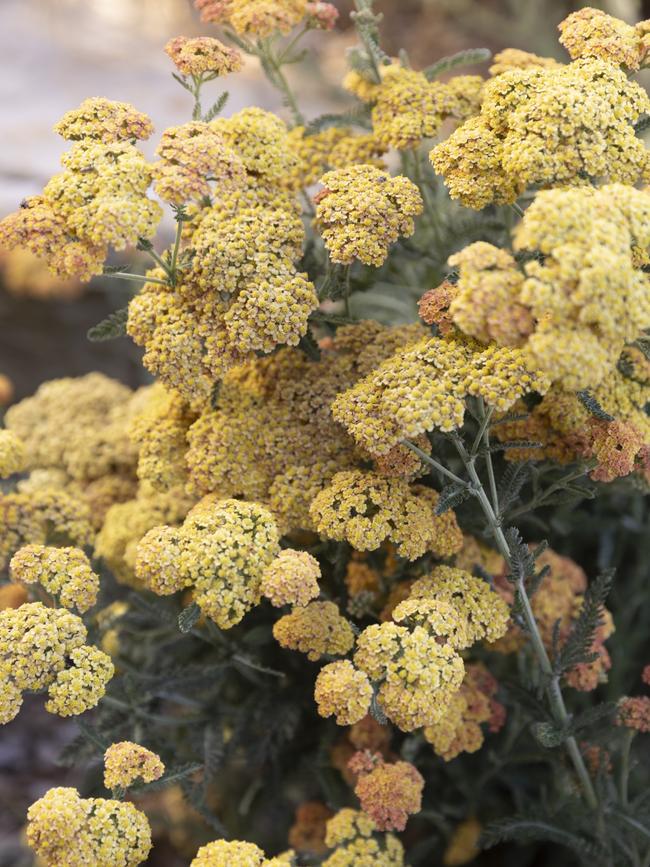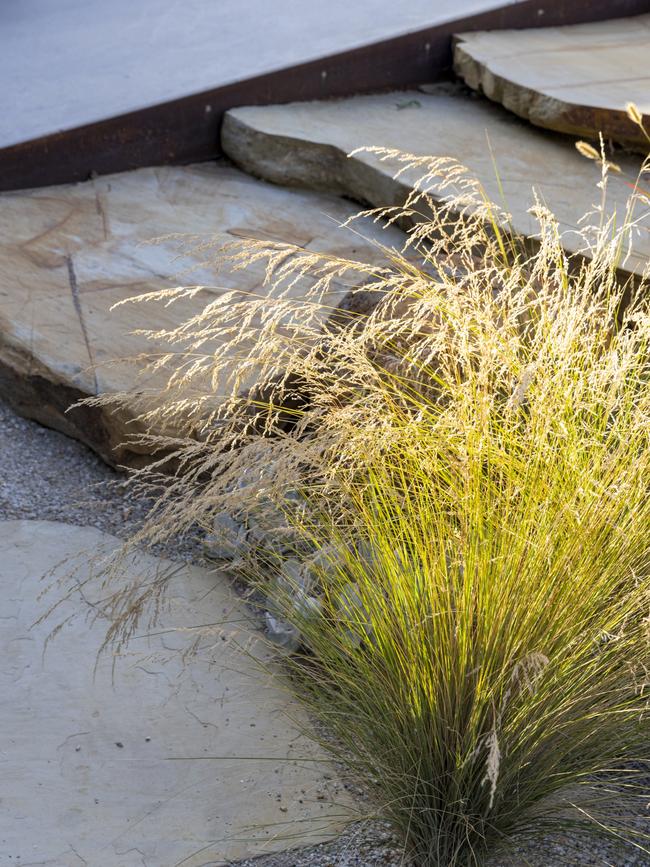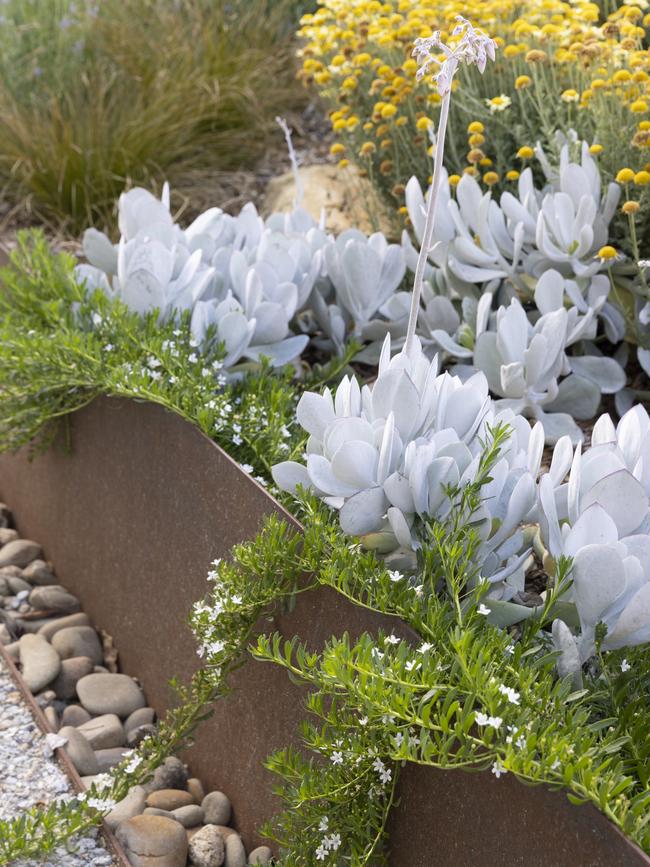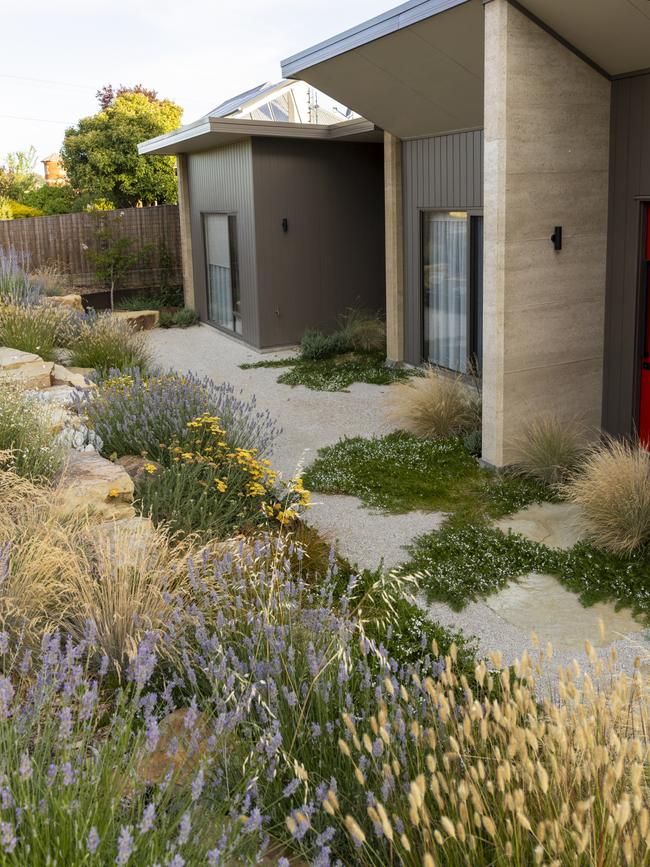Building a beautiful garden in a harsh climate is possible
This central Victorian garden is thriving despite hot dry summers, low rainfall, and soil described as ‘mining rubble, devoid of organic matter’. How did they do it?

When you have both a harsh climate and poor soil, the right choice of plants is critical to a garden’s success. That’s the specialty of Tim Pilgrim, designer and founder of Tim Pilgrim Gardens, who created the planting scheme for this garden in Castlemaine, Central Victoria, where hot dry summers and low rainfall meet soil that he describes as “mining rubble, devoid of organic matter”. The garden has no irrigation yet remains colourful, interesting and low maintenance for most of the year.
At 400 sqm, the property is not large but looks bigger due to a clever design by local landscaper and stonemason Kaya Storm of Synergy Stone. The new eco-build house was cut into a southern slope that shields the prevailing cold southerly winds and optimises the passive solar design. Instead of building a big retaining wall, Storm used a gentler option of a low wall and sloping the ground up to street level. “It extends the garden so the house is held in the space, surrounded by plants as you step out the front door. It makes it very private,” says Pilgrim. “We also borrowed some of the streetscape by extending the beds out to the nature strip.” In the back garden, a dry creek bed helps capture and hold precious rainwater from the roof before feeding it into a tank at the bottom.
The garden’s colour scheme was inspired by the tones of the home’s rammed earth walls, its orange-red front door and the spectacular sunsets. “There’s a lovely west aspect in the front garden, so there’s a large sitting stone placed to enjoy the sunsets,” says Pilgrim.


Early in the season, the flower colours are bright yellows, oranges and reds, with softer tones in autumn. Key plants include lemon Phlomis fruticosa and Anthemis ‘EC Buxton’, yellow curry plant (Helichrysum italicum) and Achillea ‘Walther Funcke’, which Pilgrim describes as “changing colours like a sunset”, from cherry red, to saffron then butter yellow. Smokebush (Cotinus ‘Grace’) contributes burgundy summer foliage and misty pink flower plumes, followed by autumn foliage. Bright red Leucadendron ‘Safari Sunset’ adds colour during winter. “There’s a big sky here, so we included blues and mauves as well, such as Russian sage (Salvia yangii) and English lavender (L. angustifolia) to bring it all together,” says Pilgrim. “We tried to design the garden as much for its flowering colour as its form and structure and movement.”


Grasses are a key element for movement and height. “We look for grasses that put on most of their growth by spring, so when it dries out in summer they’ve already reached their potential – like they’re frozen in time,” explains Pilgrim. Calamagrostis ‘Karl Foerster’ is used for its height while Pennisetum thunbergii ‘Red Buttons’ features fuzzy drumstick seed heads that nod in the breeze. The ground cover creeping boobialla (Myoporum parvifolia) is used to soften and cool the gravel surfaces across which it spreads. For structure, coastal rosemary (Westringia fruticosa), lavender and rosemary are clipped into cloud shapes, while three white crepe myrtles will provide shade as they grow.
Maintenance is a once-a-year job. “We leave it until late winter then cut back the perennials to the ground and clip the clouds, so there’s only about four weeks downtime before things start growing again,” explains Pilgrim.
The plants have been severely tested this summer. “We are begging for rain here – I don’t think we’ve had a day below 30C for a couple of months,” Pilgrim says. “It’s tough being a gardener when you’re watching your plants struggle. In a way it’s been good because it resets what you think plants can handle. You learn what can fend for itself and this garden is still looking good without irrigation.”
Q&A
I’ve been told that if I grow a tree from a blood plum seed, the resultant fruit may not be the same as the original tree. Is that correct?
Tony Mancini, Melbourne
It is correct because all seeds have genetic variability (just like our children), especially if the male pollen comes from a different tree to the female flower. It’s the basis for breeding new varieties with improved traits such as fruit size, colour and timing, as well as tree size and disease resistance. Seeds can be “true to type” in some varieties, but to be certain the offspring is exactly the same as the parent you’ll need vegetative (rather than sexual) propagation, which is from cuttings, tissue culture or aerial layering. In fruit trees, including plums, cuttings are usually grafted onto suitable rootstocks.
I bought a vanilla orchid plant by mail order. How do I make it thrive in Sydney? Any tips on hand pollinating the flowers?
Marcus Gunaratnum, Sydney
The climbing orchid Vanilla planifolia is the source of vanilla pods, produced after flowers are pollinated. However, this a tropical plant that likes temperatures around 27C, with high humidity and rainfall, plus a short dry period to induce flowering. If you can replicate these demanding conditions indoors or in a glasshouse you might succeed, otherwise they’re attractive houseplants on their own. To hand-pollinate, gently tear open the flower and use a toothpick to lift the flap covering the female stigma, then press the pollen-laden anther against it. Do this soon after the flower opens.
I’ve collected seeds from my desert rose. What’s the best way to store them?
Stan Mish-Wills, Bundaberg, Queensland
The seeds of Adenium do not stay viable for long, so for the best germination rates, sow them when fresh. You can store them for one to two years in an airtight container in the refrigerator – but don’t let them freeze.

Send your questions to: helenyoungtwig@gmail.com The best question for April will win The Tree Atlas (Lonely Planet, $70) and a Bamboo Pod Birdhouse from Annabel Trends ($29.95). March’s winner is Dawn Mitchell for her question about her mutant tomato





To join the conversation, please log in. Don't have an account? Register
Join the conversation, you are commenting as Logout